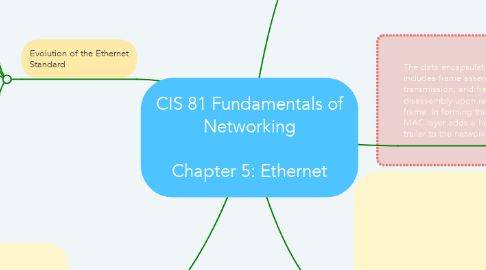CIS 81 Fundamentals of Networking Chapter 5: Ethernet
by nasrul aytam

1. Evolution of the Ethernet Standard
1.1. 1979 Bob Metcalfe developed Ethernet at XEROX PARC
1.2. 1980 DEC-Intel-Xerox (DIX) publish first original 10 Mbps Ethernet Standard over thick coaxial cable
1.3. 1985 IEEE 802.3 used DIX standard and published standard with the title IEEE 802.3 Carrier Sense Multiple Access with Collision Detection (CSMA/CD) Access Method and Physical Layer Specifications
1.4. Supplements 1985 10BASE2 Thin Ethernet 1990 10BASE-T Twisted-pair 1995 100BASE-T Fast Ethernet and Autonegotiation 1997 Full Duplex Standard 1998 1000BASE-X Gigabit Ethernet
2. Mac address
2.1. This address does not change Similar to the name of a person Known as physical address because physically assigned to the host NIC
3. Ethernet is the most widely used LAN technology today. Ethernet operates in the data link layer and the physical layer. It is a family of networking technologies that are defined in the IEEE 802.2 and 802.3 standards
4. The data encapsulation process includes frame assembly before transmission, and frame disassembly upon reception of a frame. In forming the frame, the MAC layer adds a header and trailer to the network layer PDU
5. IP address
5.1. Similar to the address of a person Based on where the host is actually located Known as a logical address because assigned logically Assigned to each host by a network administrator


